Designing a commercial kitchen
Download as ppt, pdf63 likes55,172 views
The key considerations for designing a commercial kitchen are the service requirements, available space, and budget. A good design follows the workflow of delivery, storage, preparation, cooking, holding, serving, washing up, and waste disposal. It is important to assess risks, ensure proper equipment and space for each area, and consider environmental factors like ventilation and energy efficiency.
1 of 20
Downloaded 1,919 times
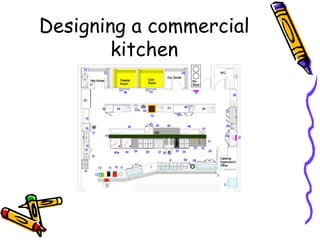
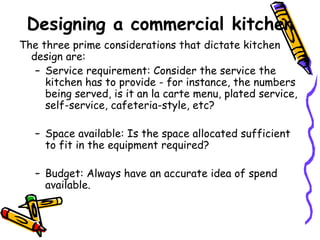
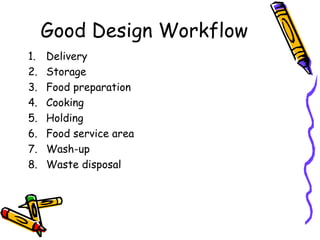
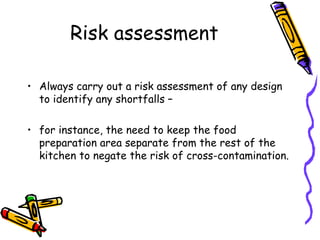

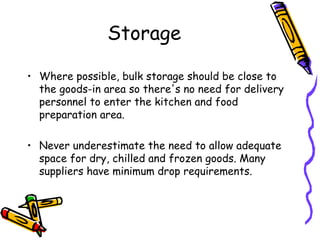
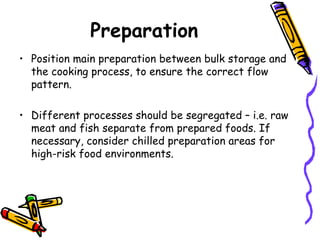


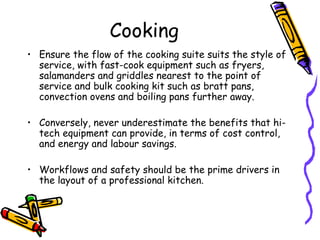



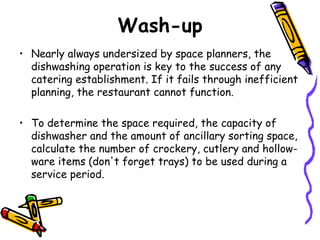
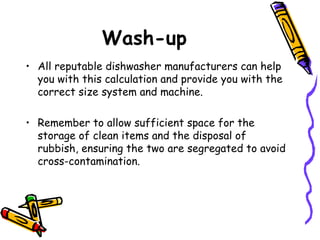

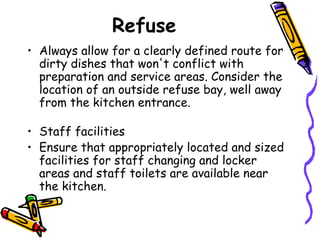
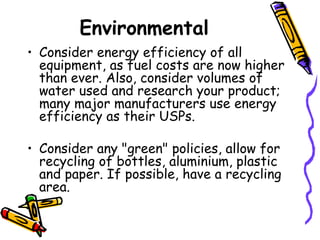


Ad
Recommended
Facility planning kitchen layout and planning
Facility planning kitchen layout and planningvikesh Kashyap
Ěý
This document discusses the key components and considerations for designing commercial kitchen layouts. It identifies six main components - clean/wash, food preparation, cooking, storage, service, and delivery areas. Proper kitchen layout and design supports workflow efficiency through an optimized work triangle of sink, stove, and refrigerator located within specific distance parameters. Common layout styles like L-shaped, U-shaped, and parallel designs are examined along with their advantages and disadvantages. Additional factors like equipment, space, and business type must also be considered to create a functional commercial kitchen.Intro to commercial kitchen design
Intro to commercial kitchen designMichelleWidner
Ěý
The document provides guidance on programming and designing commercial kitchen spaces. It emphasizes gathering information from clients about their menu, storage needs, staffing, and equipment requirements. Key components of kitchen design include clean/wash, food preparation, cooking, storage, service, and delivery areas. Designs must comply with international, federal, state and local codes regarding safety, accessibility and food handling. Floor plans should thoughtfully arrange these areas to support efficient food production flow.Food and beverage_operations
Food and beverage_operationslibfsb
Ěý
This document outlines a training module on food and beverage operations. It includes a description of the module's aims to provide an understanding of operational and supervisory aspects of running food and beverage establishments. The learning outcomes cover key areas of food and beverage operations. The syllabus details the topics that will be covered in each of the 8 chapters, including food production, purchasing, menu planning, and banqueting. Learners will be assessed through a 2.5 hour exam covering short and long answer questions.Body language
Body languageCU UNIVERSITY
Ěý
Body language is a form of non-verbal communication that conveys information through gestures, posture, expressions, and eye movements. Around 55% of communication is non-verbal. Body language includes kinesics (body movements), proxemics (use of space), and haptics (touch). Maintaining eye contact, nodding, keeping an open posture, and smiling can communicate confidence and interest, while avoiding crossed arms, excessive fidgeting, and poor posture can undermine non-verbal messages. Understanding one's own body language and reading that of others is an important communication skill.URINE FORMATION
URINE FORMATION sakshi nayak
Ěý
The document provides an overview of the urinary system, detailing its components such as kidneys, ureters, bladder, and urethra, and their functions in urine formation. It explains the structure and function of nephron units, the processes of glomerular filtration, tubular reabsorption, and secretion involved in urine formation, as well as the regulatory mechanisms influencing these processes. Additionally, it discusses potential urinary disorders and abnormal urinary constituents indicating various diseases.Project Management Restaurant
Project Management Restaurant Mostafa Ahmed Zein
Ěý
The document is a project management report for a restaurant project submitted by five students. It includes sections on scope management, cost management, time management, and quality management. The scope management section includes the vision, mission, work breakdown structure, SWOT analysis, and project charter. The cost management section includes sales forecasts, financial analyses like NPV, ROI, and payback period. Time management includes a PDM diagram, while quality management uses a fishbone diagram to analyze the root causes of food waste.Case Study -Hotel design
Case Study -Hotel designhebasayeed
Ěý
The document summarizes the design of the Surya Hotel Executive in Solapur, Maharashtra, India. It describes the location and climate. The five-zone plan includes public spaces, guest rooms, recreation, restaurants, and services. Zone 1 includes parking, lobby, and corridors. Zone 2 contains guest rooms. Zone 3 has lawn, gym, fountain and outdoor seating. Zone 4 is for restaurants. Zone 5 covers elevators, stairs, electricity and ducts. The design aims to achieve thermal comfort while reducing material waste and maximizing vegetation.RESTAURANT DESIGN
RESTAURANT DESIGNNightKing9
Ěý
The document provides an outline for the contents of a literature review and case study on restaurant design. It includes sections on defining restaurants and their classification, describing various spaces within a restaurant like the dining area, kitchen, restrooms and patio. It also discusses elements of restaurant design like circulation, entrance, parking, lighting, noise control and case studies of specific restaurants. The document aims to comprehensively cover all aspects of planning and designing restaurant spaces.Cafeteria
CafeteriaLaraib Ahsan
Ěý
A cafeteria is a self-service food service location found in institutions like offices and schools. Customers select food from various food stalls or counters and pay at the end of the line. Cafeterias are mainly classified as traditional or free-flow. In a traditional cafeteria, customers move down a straight line of counters selecting food. In a free-flow cafeteria, counters are arranged in various layouts allowing customers to choose which station to visit first to select their food.Commercial Kitchen Design and Planning
Commercial Kitchen Design and Planning ReitanoDesignGroup
Ěý
The document discusses various aspects of culinary space planning, including efficiency in kitchen design and the importance of optimizing equipment and workflow. It highlights significant issues such as energy consumption in foodservice and strategies for reducing food waste, which costs the US $1 billion annually. Key themes include consumer experience, sustainability, and collaboration within foodservice environments.Restaurant atomsphere
Restaurant atomsphereYamini Soni
Ěý
The document discusses the importance of creating a pleasing atmosphere in restaurant design, emphasizing that factors like sight, smell, sound, temperature, and decor influence customer experiences and their likelihood to return. It outlines specific elements such as exterior design, signage, lighting, color schemes, and furnishings that contribute to the overall dining ambiance. The goal is to balance comfort and aesthetic appeal to attract and retain customers, ultimately impacting the restaurant's profitability.Linens, tableware and chinaware
Linens, tableware and chinawareAnnalyn Peña
Ěý
The document discusses different types of linens, tableware, and glassware used for serving food and drinks. It describes common linens like tablecloths, napkins, and runners that are often made from materials like linen, cotton, or synthetic fibers. It also lists different types of cutlery/flatware used for eating like forks, knives, spoons, and serving utensils. Additionally, it outlines the key parts of glassware - the bowl, stem, and foot - and common varieties including tumblers, footed glasses, and mugs.Commercial Kitchen Equipment
Commercial Kitchen EquipmentSher Thapa
Ěý
The document outlines essential commercial kitchen equipment used in restaurants, hotels, and cafeterias, including ovens, grills, fryers, and various utensils. Additionally, it provides tips for buyers on factors to consider before purchasing kitchen equipment, such as capacity, safety, and maintenance. Overall, it serves as a checklist and guide for effective kitchen operations.Buffet service
Buffet serviceAnne Francis Villegas
Ěý
A buffet meal involves guests serving themselves from various dishes displayed on a table. There are several types of buffet services including plate buffet, tray buffet, and sit-down buffet. Planning the buffet involves arranging dishes in order of importance, choosing easily self-served foods, and having enough seating and serving space. The buffet table is decorated and set with dishes, flatware, and drinks before guests are invited to serve themselves family style.Kitchen presentation
Kitchen presentationmilcrez
Ěý
A kitchen is a room used for cooking, food preparation, and related tasks. Modern residential kitchens typically include appliances like a stove, sink, refrigerator, and cabinets. Commercial kitchens found in restaurants and other establishments tend to be larger with heavier-duty equipment and are subject to public health regulations. Kitchens in schools for teaching cooking skills have multiple workstations with individual ovens and equipment. Proper kitchen design with well-planned cabinets and appliances can create an efficient workspace.Furnitures in restaurant
Furnitures in restaurantCarloskdk
Ěý
This document summarizes different types of furniture used in restaurants, including tables, chairs, sideboards, hostess desks, and bar stools. It describes the various sizes and styles of restaurant tables like square, rectangular, and round tables that can seat different numbers of people. It also provides specifications for chairs, sideboards used for storing serving items, hostess desks near entrances, and tall rotating bar stools.Restaurant Design Presentation
Restaurant Design Presentationmaggielair
Ěý
The document provides design details for the Top Hat restaurant and lounge, including concept, floor plans, elevations, renderings, and room justifications. The design concept aims to create an elegant, high-end atmosphere inspired by 1940s Chicago style. Gold, crystal chandeliers, crimson textiles, and art deco features will be used to achieve this mood. The lounge will include a dance floor and stage for live jazz music.TYPES OF RESTAURANT
TYPES OF RESTAURANTJaydeep Singh
Ěý
The document discusses the history and types of restaurants. It notes that the idea of selling food for profit dates back to ancient civilizations, with examples given of restaurants in Ancient Greece and Rome. The first modern restaurant is said to have opened in Paris in 1765. The document then lists and describes 10 common types of restaurants, including coffee shops, specialty restaurants, grill rooms, dining rooms, and fast food restaurants. It provides examples of each type and highlights characteristics like menus, services, pricing, and locations in Ahmedabad, India.Kitchen stewarding department
Kitchen stewarding departmentindian chefrecipe
Ěý
The kitchen stewarding department is responsible for cleaning all dishware, cutlery, glassware, and cookware. It plays a vital role in food production and service by ensuring clean equipment and facilities. The department is headed by a kitchen stewarding manager who oversees shift supervisors and utility workers performing cleaning duties like washing dishes, polishing silverware, cleaning the kitchen and staff cafeteria, and garbage disposal. Proper supervision and preventative maintenance is important for the smooth functioning of the department.Case Study on Restaurant
Case Study on RestaurantCET, BBSR
Ěý
The BLUFISH restaurant in Beijing, China was designed by SODA Architects to resemble an underwater world. The 210 square meter space uses a blue and pink colored metal mesh ceiling and white curved walls to create different dining areas including a waiting area, dining space, kitchen, and washing area. Decorative elements like mosaic tile floors with sea creature patterns and colored metallic ceiling patterns further enhance the underwater theme.Kitchen powerpoint
Kitchen powerpointksovon31
Ěý
This document discusses a group project on kitchen design. It lists the group members and topics to be discussed, including the definition of a kitchen, history of kitchens, kitchen design principles, and components like cabinets, ventilation, and plumbing. The topics provide an overview of kitchen fundamentals from functions to styles to layouts and systems.Space Planning Of Kitchen
Space Planning Of KitchenAndhra University
Ěý
The document discusses various aspects of kitchen design, including layout options, the kitchen work triangle, and guidelines for planning efficient spaces. It emphasizes the importance of optimizing areas for food preparation, storage, and cleaning, as well as incorporating functional design elements and appropriate materials. The document also explores different kitchen styles and components, underlining that a well-organized kitchen enhances both functionality and family interaction.Restaurant Design .pptx
Restaurant Design .pptxBinisha Raut
Ěý
This document discusses key considerations for restaurant design, including definitions, history, and types of restaurants. It covers topics like anthropometry, circulation space, dining areas, kitchen layouts, lighting, seating, and other interior and exterior design elements. Three case studies of existing restaurants are presented: Timmur Restaurant in Siraichuli, Riverview Restaurant, and Blufish Restaurant. Blufish's concept was to create an underwater-themed space using hand-drawn patterns. Key areas of a restaurant like the kitchen, dining room, and restrooms are compared across the three case studies.Banquet Standards
Banquet StandardsRasmitaMarandi
Ěý
The document outlines standards and guidelines for banquet hall designs, including table sizes and seating capacities for various table shapes and configurations. It covers different layout styles such as classic, conference, and hollow square, as well as considerations for space efficiency and dining area requirements. It also details necessary facilities for kitchens, washrooms, and changing rooms, alongside recommendations for dimensions and placements to enhance functionality.Kitchen presentation
Kitchen presentationManish Khatri
Ěý
The document provides information about kitchen planning and design. It discusses key considerations for kitchen layout such as work triangle dimensions, appliance placement, and cabinet sizes. Different kitchen styles like traditional, contemporary, and coastal are described. The document also covers types of kitchen layouts including one-wall, L-shaped, U-shaped, and island kitchens. Modular kitchen components like base cabinets, baskets, and pull-outs are explained. Proper planning of a kitchen considers functionality, storage, and aesthetics.Dining Room Presentation
Dining Room PresentationKaru D
Ěý
This document discusses the various items used in table settings. It describes dinnerware, flatware, beverageware, linens and appointments needed for individual covers and serving pieces. Dinnerware includes plates in different sizes for meals as well as bowls. Flatware consists of knives, forks and spoons. Beverageware comes in footed stemware and unfooted tumblers. Linens include tablecloths, placemats, runners and napkins. The document provides details on appropriate sizes and materials for each item. It also lists an assignment to create a scrapbook or presentation showing examples of these table appointment categories.Restaturant 26.12.13
Restaturant 26.12.13Atikul Islam
Ěý
This document contains case studies and standard measurements for restaurant design. It includes case studies of four restaurants - The Donut Stop in Philadelphia, Pio Pio in New York, Khutum Bari in Lalmatia, and Dingi in Dhaka. For each case, it describes the location, concept, plan, circulation, zoning, sections, massing, and solid to void relationships. It also provides standard measurements for dining space, service areas, seating, bars, and other restaurant elements. Dimensioned drawings illustrate typical restaurant dimensions and proportions. The document is a reference for restaurant design best practices and case studies.Electrical services in kitchen and dining
Electrical services in kitchen and diningManoj Dasi
Ěý
The document discusses electrical systems and layouts for kitchens. It covers typical circuits needed in a kitchen including dedicated circuits for appliances like the electric range, refrigerator, dishwasher, and small appliance loads. It also discusses lighting circuits and different types of lighting used in kitchens and dining areas, including under cabinet lights, track lighting, and cove lighting. The document provides information on typical kitchen appliances, electrical safety precautions, and earthing and ducting requirements.M6 cp martensdragalinm
M6 cp martensdragalinmMichelle Martens-Dragalin, M.Ed.
Ěý
This document summarizes the evolution of the overhead projector in education. It describes how overhead projectors were widely used from the 1940s-1980s but have now been replaced by newer technologies like LCD projectors and document cameras. The document interviews educators and administrators who discuss how technology needs are identified and budgets determined. While newer technologies can engage students more, some teachers only use technology if necessary. Overall, it shows how educational technology has advanced over time but depends on teachers' willingness to learn and use new tools.Kitchen Plan & Elevation Drawing
Kitchen Plan & Elevation Drawinglubomirsloboda
Ěý
1. All cabinets will be oak wood with hardware installed on site. Crown molding will match cabinet color.
2. Cabinet styles and colors must be confirmed with the homeowner prior to ordering.
3. Plans show the layout and dimensions of 27 cabinets for the kitchen, including wall cabinets, base cabinets, and utility cabinets. Appliance locations and specifications are also noted.More Related Content
What's hot (20)
Cafeteria
CafeteriaLaraib Ahsan
Ěý
A cafeteria is a self-service food service location found in institutions like offices and schools. Customers select food from various food stalls or counters and pay at the end of the line. Cafeterias are mainly classified as traditional or free-flow. In a traditional cafeteria, customers move down a straight line of counters selecting food. In a free-flow cafeteria, counters are arranged in various layouts allowing customers to choose which station to visit first to select their food.Commercial Kitchen Design and Planning
Commercial Kitchen Design and Planning ReitanoDesignGroup
Ěý
The document discusses various aspects of culinary space planning, including efficiency in kitchen design and the importance of optimizing equipment and workflow. It highlights significant issues such as energy consumption in foodservice and strategies for reducing food waste, which costs the US $1 billion annually. Key themes include consumer experience, sustainability, and collaboration within foodservice environments.Restaurant atomsphere
Restaurant atomsphereYamini Soni
Ěý
The document discusses the importance of creating a pleasing atmosphere in restaurant design, emphasizing that factors like sight, smell, sound, temperature, and decor influence customer experiences and their likelihood to return. It outlines specific elements such as exterior design, signage, lighting, color schemes, and furnishings that contribute to the overall dining ambiance. The goal is to balance comfort and aesthetic appeal to attract and retain customers, ultimately impacting the restaurant's profitability.Linens, tableware and chinaware
Linens, tableware and chinawareAnnalyn Peña
Ěý
The document discusses different types of linens, tableware, and glassware used for serving food and drinks. It describes common linens like tablecloths, napkins, and runners that are often made from materials like linen, cotton, or synthetic fibers. It also lists different types of cutlery/flatware used for eating like forks, knives, spoons, and serving utensils. Additionally, it outlines the key parts of glassware - the bowl, stem, and foot - and common varieties including tumblers, footed glasses, and mugs.Commercial Kitchen Equipment
Commercial Kitchen EquipmentSher Thapa
Ěý
The document outlines essential commercial kitchen equipment used in restaurants, hotels, and cafeterias, including ovens, grills, fryers, and various utensils. Additionally, it provides tips for buyers on factors to consider before purchasing kitchen equipment, such as capacity, safety, and maintenance. Overall, it serves as a checklist and guide for effective kitchen operations.Buffet service
Buffet serviceAnne Francis Villegas
Ěý
A buffet meal involves guests serving themselves from various dishes displayed on a table. There are several types of buffet services including plate buffet, tray buffet, and sit-down buffet. Planning the buffet involves arranging dishes in order of importance, choosing easily self-served foods, and having enough seating and serving space. The buffet table is decorated and set with dishes, flatware, and drinks before guests are invited to serve themselves family style.Kitchen presentation
Kitchen presentationmilcrez
Ěý
A kitchen is a room used for cooking, food preparation, and related tasks. Modern residential kitchens typically include appliances like a stove, sink, refrigerator, and cabinets. Commercial kitchens found in restaurants and other establishments tend to be larger with heavier-duty equipment and are subject to public health regulations. Kitchens in schools for teaching cooking skills have multiple workstations with individual ovens and equipment. Proper kitchen design with well-planned cabinets and appliances can create an efficient workspace.Furnitures in restaurant
Furnitures in restaurantCarloskdk
Ěý
This document summarizes different types of furniture used in restaurants, including tables, chairs, sideboards, hostess desks, and bar stools. It describes the various sizes and styles of restaurant tables like square, rectangular, and round tables that can seat different numbers of people. It also provides specifications for chairs, sideboards used for storing serving items, hostess desks near entrances, and tall rotating bar stools.Restaurant Design Presentation
Restaurant Design Presentationmaggielair
Ěý
The document provides design details for the Top Hat restaurant and lounge, including concept, floor plans, elevations, renderings, and room justifications. The design concept aims to create an elegant, high-end atmosphere inspired by 1940s Chicago style. Gold, crystal chandeliers, crimson textiles, and art deco features will be used to achieve this mood. The lounge will include a dance floor and stage for live jazz music.TYPES OF RESTAURANT
TYPES OF RESTAURANTJaydeep Singh
Ěý
The document discusses the history and types of restaurants. It notes that the idea of selling food for profit dates back to ancient civilizations, with examples given of restaurants in Ancient Greece and Rome. The first modern restaurant is said to have opened in Paris in 1765. The document then lists and describes 10 common types of restaurants, including coffee shops, specialty restaurants, grill rooms, dining rooms, and fast food restaurants. It provides examples of each type and highlights characteristics like menus, services, pricing, and locations in Ahmedabad, India.Kitchen stewarding department
Kitchen stewarding departmentindian chefrecipe
Ěý
The kitchen stewarding department is responsible for cleaning all dishware, cutlery, glassware, and cookware. It plays a vital role in food production and service by ensuring clean equipment and facilities. The department is headed by a kitchen stewarding manager who oversees shift supervisors and utility workers performing cleaning duties like washing dishes, polishing silverware, cleaning the kitchen and staff cafeteria, and garbage disposal. Proper supervision and preventative maintenance is important for the smooth functioning of the department.Case Study on Restaurant
Case Study on RestaurantCET, BBSR
Ěý
The BLUFISH restaurant in Beijing, China was designed by SODA Architects to resemble an underwater world. The 210 square meter space uses a blue and pink colored metal mesh ceiling and white curved walls to create different dining areas including a waiting area, dining space, kitchen, and washing area. Decorative elements like mosaic tile floors with sea creature patterns and colored metallic ceiling patterns further enhance the underwater theme.Kitchen powerpoint
Kitchen powerpointksovon31
Ěý
This document discusses a group project on kitchen design. It lists the group members and topics to be discussed, including the definition of a kitchen, history of kitchens, kitchen design principles, and components like cabinets, ventilation, and plumbing. The topics provide an overview of kitchen fundamentals from functions to styles to layouts and systems.Space Planning Of Kitchen
Space Planning Of KitchenAndhra University
Ěý
The document discusses various aspects of kitchen design, including layout options, the kitchen work triangle, and guidelines for planning efficient spaces. It emphasizes the importance of optimizing areas for food preparation, storage, and cleaning, as well as incorporating functional design elements and appropriate materials. The document also explores different kitchen styles and components, underlining that a well-organized kitchen enhances both functionality and family interaction.Restaurant Design .pptx
Restaurant Design .pptxBinisha Raut
Ěý
This document discusses key considerations for restaurant design, including definitions, history, and types of restaurants. It covers topics like anthropometry, circulation space, dining areas, kitchen layouts, lighting, seating, and other interior and exterior design elements. Three case studies of existing restaurants are presented: Timmur Restaurant in Siraichuli, Riverview Restaurant, and Blufish Restaurant. Blufish's concept was to create an underwater-themed space using hand-drawn patterns. Key areas of a restaurant like the kitchen, dining room, and restrooms are compared across the three case studies.Banquet Standards
Banquet StandardsRasmitaMarandi
Ěý
The document outlines standards and guidelines for banquet hall designs, including table sizes and seating capacities for various table shapes and configurations. It covers different layout styles such as classic, conference, and hollow square, as well as considerations for space efficiency and dining area requirements. It also details necessary facilities for kitchens, washrooms, and changing rooms, alongside recommendations for dimensions and placements to enhance functionality.Kitchen presentation
Kitchen presentationManish Khatri
Ěý
The document provides information about kitchen planning and design. It discusses key considerations for kitchen layout such as work triangle dimensions, appliance placement, and cabinet sizes. Different kitchen styles like traditional, contemporary, and coastal are described. The document also covers types of kitchen layouts including one-wall, L-shaped, U-shaped, and island kitchens. Modular kitchen components like base cabinets, baskets, and pull-outs are explained. Proper planning of a kitchen considers functionality, storage, and aesthetics.Dining Room Presentation
Dining Room PresentationKaru D
Ěý
This document discusses the various items used in table settings. It describes dinnerware, flatware, beverageware, linens and appointments needed for individual covers and serving pieces. Dinnerware includes plates in different sizes for meals as well as bowls. Flatware consists of knives, forks and spoons. Beverageware comes in footed stemware and unfooted tumblers. Linens include tablecloths, placemats, runners and napkins. The document provides details on appropriate sizes and materials for each item. It also lists an assignment to create a scrapbook or presentation showing examples of these table appointment categories.Restaturant 26.12.13
Restaturant 26.12.13Atikul Islam
Ěý
This document contains case studies and standard measurements for restaurant design. It includes case studies of four restaurants - The Donut Stop in Philadelphia, Pio Pio in New York, Khutum Bari in Lalmatia, and Dingi in Dhaka. For each case, it describes the location, concept, plan, circulation, zoning, sections, massing, and solid to void relationships. It also provides standard measurements for dining space, service areas, seating, bars, and other restaurant elements. Dimensioned drawings illustrate typical restaurant dimensions and proportions. The document is a reference for restaurant design best practices and case studies.Electrical services in kitchen and dining
Electrical services in kitchen and diningManoj Dasi
Ěý
The document discusses electrical systems and layouts for kitchens. It covers typical circuits needed in a kitchen including dedicated circuits for appliances like the electric range, refrigerator, dishwasher, and small appliance loads. It also discusses lighting circuits and different types of lighting used in kitchens and dining areas, including under cabinet lights, track lighting, and cove lighting. The document provides information on typical kitchen appliances, electrical safety precautions, and earthing and ducting requirements.Viewers also liked (16)
M6 cp martensdragalinm
M6 cp martensdragalinmMichelle Martens-Dragalin, M.Ed.
Ěý
This document summarizes the evolution of the overhead projector in education. It describes how overhead projectors were widely used from the 1940s-1980s but have now been replaced by newer technologies like LCD projectors and document cameras. The document interviews educators and administrators who discuss how technology needs are identified and budgets determined. While newer technologies can engage students more, some teachers only use technology if necessary. Overall, it shows how educational technology has advanced over time but depends on teachers' willingness to learn and use new tools.Kitchen Plan & Elevation Drawing
Kitchen Plan & Elevation Drawinglubomirsloboda
Ěý
1. All cabinets will be oak wood with hardware installed on site. Crown molding will match cabinet color.
2. Cabinet styles and colors must be confirmed with the homeowner prior to ordering.
3. Plans show the layout and dimensions of 27 cabinets for the kitchen, including wall cabinets, base cabinets, and utility cabinets. Appliance locations and specifications are also noted.Vartika Khandelwal MSc-ID
Vartika Khandelwal MSc-ID dezyneecole
Ěý
This document provides specifications for a kitchen design including:
- The size of the kitchen is 14' x 9'11" (138.6 square feet) and the working triangle is 19'3".
- It includes a list of storage units, appliances, and other items with their sizes and quantities.
- Diagrams show the layout of the kitchen including the location of overhead and base cabinets, appliances, and designated storage areas.Chapter 8: Front Office Accounting
Chapter 8: Front Office AccountingNicole Hay-Walters
Ěý
This document discusses front office accounting fundamentals and processes. It covers topics like creating and maintaining front office accounts, folios, vouchers, points of sale, and ledgers. Specifically, it describes how front office accounts are created for guests and non-guests during check-in and reservations. It also explains how transactions are recorded on folios to track charges and payments. The document highlights how automated systems now integrate these front office accounting functions.Maxillary Premolars
Maxillary Premolarssyedsadatullah
Ěý
1. Maxillary premolars are located between the anterior teeth and molars, and assist in tearing and chewing food.
2. The maxillary first premolar has two cusps, a longer buccal cusp and shorter lingual cusp, and usually has two roots.
3. The maxillary second premolar resembles the first but has a less pointed buccal cusp and deeper developmental depression on the distal aspect, and usually has a single root.Türkiye’de mikrokredi uygulamaları ışığında kobi̇’leşme i̇çin tasarım önerisi
Türkiye’de mikrokredi uygulamaları ışığında kobi̇’leşme i̇çin tasarım önerisiGulderenyigit
Ěý
The Presentation of Graduation Thesis About Microcreditİnsan Kaynakları Yönetimi - Eğitim ve Geliştirme
İnsan Kaynakları Yönetimi - Eğitim ve GeliştirmeOsman Nar
Ěý
Eğitim, “işle ilgili yetkinliklerin çalışanlar tarafından öğrenilmesini kolaylaştırmada örgüt tarafından planlanmış çaba” olarak tanımlanabilir. Bu yetkinlikler başarılı iş performansı için çözümsel olan bilgi, beceri ve davranışları içermektedir. Eğitimin amacı; eğitim programlarının temelindeki bilgi, beceri ve davranışlara personelin sahip olmasını ve onların günlük faaliyetlerinde bunlara başvurmalarını sağlamaktır.
İnsan Kaynakları Yönetimi İş Analizi
İnsan Kaynakları Yönetimi İş AnaliziErciyes University Faculty of Communication
Ěý
TC. Erciyes Ăśniversitesi
Ä°letiĹźim FakĂĽltesi
Halkla İlişkiler ve Tanıtım Bölümü
İnsan Kaynakları Yönetimi Dersi Notları
Öğr. Gör. Mustafa CıngıKitchen layouts module 9 management of food preparation & service
Kitchen layouts module 9 management of food preparation & serviceMaxine Walters-Pitt
Ěý
This document discusses kitchen layouts and ergonomics. It defines key terms like work triangle and identifies the main kitchen layout types: single wall, L-shaped, U-shaped, and parallel wall. For each layout, it describes advantages and disadvantages. The ideal work triangle distances between the sink, stove and refrigerator are provided. Activity centers in the kitchen include the mixing/preparation, washing/cleanup, and cooking/serving centers, which relate to the work triangle sequence.K TO 12 T.L.E MODULE GRADE 8
K TO 12 T.L.E MODULE GRADE 8christian gurion
Ěý
This document contains the initials T.L.E., a name Christian David Gurion, a student ID 8-ABAD-SANTOS, and the name of a teacher Mrs. Diaz. It appears to be identifying information for a student, but provides very little other context to understand its full purpose or meaning.Akış Şemaları ( İş Analizi ve Uygulamaları Dersi)
Akış Şemaları ( İş Analizi ve Uygulamaları Dersi)Tugba Ozen
Ěý
İş Analizi dersi için ödev; iş akışlarını, sorunlarını ve işlem sıralarını takip edebilmek için oluşturulan akış şemalarının şekil, anlam ve kullanım tekniklerini anlatan bir çalışma.
Türkiye’de mikrokredi uygulamaları ışığında kobi̇’leşme i̇çin tasarım önerisi
Türkiye’de mikrokredi uygulamaları ışığında kobi̇’leşme i̇çin tasarım önerisiGulderenyigit
Ěý
Ad
Similar to Designing a commercial kitchen (20)
Lesson 5 planning and equipping the kitchen
Lesson 5 planning and equipping the kitchenMervyn Maico Aldana
Ěý
Kitchen planning involves allocating space for equipment based on needs and traffic flows. Equipment is selected based on the menu to minimize steps for staff. There are trends toward more efficient equipment like combination ovens that use less energy and integrate functions. Selecting equipment considers menu items, volume, and speed of service while ensuring efficiency and sustainability.New notes2 FOOD PRODUCTION 3 RD SEMESTER
New notes2 FOOD PRODUCTION 3 RD SEMESTERN SENTHIL KUMAR
Ěý
The document provides guidance on designing an efficient kitchen layout and operation. It discusses several key considerations for kitchen design including reducing physical fatigue for employees, minimizing noise and ensuring adequate lighting, temperature control and compliance with safety codes. It also outlines different kitchen layout options and important design factors to consider like costs, equipment needs, space and sanitation. General guidelines are provided for lighting, ventilation, floors, walls, ceilings and storage areas. Industrial catering management models and cafeteria operations are briefly covered.The Ultimate Restaurant Equipment Guide : Your Kitchen Checklist
The Ultimate Restaurant Equipment Guide : Your Kitchen Checklistpshospitalityservice
Ěý
The document is a guide to essential restaurant equipment, emphasizing the importance of choosing the right tools for efficiency, food quality, and customer satisfaction. It lists necessary equipment such as ovens, fryers, and refrigerators, while highlighting factors to consider before purchasing, including budget, space, menu compatibility, energy efficiency, and safety. Contact information for the service provider is also included.Week 10 Food And Beverage Production Methods 2 2552
Week 10 Food And Beverage Production Methods 2 2552Pavit Tansakul
Ěý
The document describes various food and beverage production methods. It discusses the goals of food production from the customer's perspective and obstacles to meeting those goals. It then outlines several solutions to those obstacles, including separating production into steps, final cooking close to service, reusing unused items, and maintaining quality. The document also explains different food production systems like centralized production and cook-chill/cook-freeze methods. It provides details on classic kitchen organization and sous vide production. Finally, it categorizes beverage production into raw, semi-prepared, and fully prepared methods.Tejtara
TejtaraTej tara
Ěý
The document discusses the creation and regulation of commercial kitchens, emphasizing the importance of food safety and cleanliness. It details the inspection process, licensing requirements, and the equipment necessary for efficient food preparation. Additionally, it highlights the collaboration with local health departments to ensure compliance with safety guidelines and the design of effective workspaces.Develop and Update Hospitality Industry Knowledge
Develop and Update Hospitality Industry KnowledgeBernie
Ěý
The document outlines the diverse establishments within the hospitality industry, primarily focusing on kitchens that range from fine dining restaurants to event catering. It discusses the organizational structure, operational differences, and unique food production methods employed in each type of establishment, emphasizing the importance of efficient kitchen layouts and food flow. Additionally, it highlights how specific sectors like travel, hospitals, and prisons manage food production and service for their targeted audiences.COMMERCIAL KITCHEN SOLUTIONS IN DUBAI
COMMERCIAL KITCHEN SOLUTIONS IN DUBAICrazysoftSolutions
Ěý
This guide outlines the steps necessary for setting up a commercial kitchen, emphasizing planning, design, compliance, and equipment selection. It covers essential elements such as utility installations, food safety practices, staffing and training, and operational management. By following these guidelines, one can create an efficient and compliant kitchen tailored to specific business needs.Catering Service Supplies and Equipment (1).pptx
Catering Service Supplies and Equipment (1).pptxMaLeedelosReyes2
Ěý
The document provides information on supplies and equipment needed for front of house, back of house, and rentals for catering services.
For front of house, it discusses supplies like flatware, glassware, napkins and tablecloths that are placed on tables, as well as supplies like cutlery and side plates kept at service stations.
For back of house, it outlines cooking equipment, storage equipment, food prep equipment and janitorial equipment needed in the kitchen area.
It also discusses factors to consider when obtaining and storing catering supplies and equipment, such as design based on service type, workstation layout, and properly storing items in a climate controlled storage unit.Principals of quantity cooking
Principals of quantity cookingindian chefrecipe
Ěý
Quantity, bulk, and volume cooking refer to cooking large amounts of food for many people, such as for special events. While the cooking methods and ingredients are the same, the scale is much larger. Careful planning, hygiene, proper equipment, purchasing, cost control, and waste management are especially important for quantity cooking to ensure quality, safety, and profitability. Skilled labor is also required to maintain taste and authenticity when cooking in large volumes.Commercial Kitchen Equipment | Tejtara
Commercial Kitchen Equipment | TejtaraTej tara
Ěý
Commercial kitchens are designed for efficient food preparation and safety, requiring compliance with cleanliness and safe handling standards. Tejtara provides modular kitchen solutions that are inspected and licensed by health departments, ensuring they meet necessary requirements like proper dishwashing and refrigeration. Their commercial kitchens are equipped with specialized equipment for food processing, emphasizing a layout that promotes safety and efficiency in operations.Kitchen design
Kitchen designShilpa
Ěý
The document outlines key considerations for designing a hotel kitchen, emphasizing its crucial role in food service operations. It details the main sections of a kitchen, including cleaning/washing, storage, food preparation, meal cooking, and service areas, while highlighting space requirements, layout designs, and essential kitchen equipment. Effective kitchen design aims to enhance efficiency, ensure safety, and facilitate smooth operation based on the menu and tasks performed.Commercial Kitchen Design The 6 Design Principles You Should Know.pptx
Commercial Kitchen Design The 6 Design Principles You Should Know.pptxNWCE Foodservice Equipment
Ěý
The document outlines six essential design principles for creating efficient commercial kitchens, emphasizing modularity, flexibility, simplicity, optimized flow, sanitation, and ease of supervision. It highlights the need for adaptable layouts, effective workflow, and hygienic environments to ensure safety and efficiency. These principles aim to enhance productivity while maintaining high standards of food quality and hygiene in commercial kitchen operations.Helpful tips when designing a commercial kitchen
Helpful tips when designing a commercial kitchen garnersfseuk
Ěý
The document provides tips for designing a commercial kitchen, emphasizing the importance of functionality and safety. Key considerations include creating efficient pathways between workstations, ensuring adequate storage space, providing sufficient counters, and maintaining proper lighting and ventilation. The advice aims to help those designing their kitchens independently to avoid common pitfalls and enhance operational efficiency.COMMERCIAL KITCHEN RESEARCH- Design studio.pdf
COMMERCIAL KITCHEN RESEARCH- Design studio.pdfAtikAhmed19
Ěý
The document summarizes the key areas and considerations for commercial kitchen layout and design. It outlines five main work areas: 1) preparation, 2) cooking, 3) storage, 4) cleaning and washing, and 5) service. For each area, it describes the functions and important equipment. It also discusses safety and security standards as well as common materials used like ceramic tile flooring, ceilings, and washable wall finishes. The document provides an overview of the essential spatial organization and features of an effective commercial kitchen.Design and Layout Presentation.pptx
Design and Layout Presentation.pptxNadiaAbbas7
Ěý
The document outlines the steps and considerations for designing and developing layouts for foodservice facilities, emphasizing optimum space allocation and flow of work. Key factors include assessing space requirements based on menu analysis, ensuring compliance with ADA guidelines, and creating efficient traffic patterns in the kitchen and dining areas. Additionally, it covers the importance of collaborating with contractors and using precise schematics for space planning.Kitchen-Stewarding-Layout-A-Comprehensive-Guide (1).pdf
Kitchen-Stewarding-Layout-A-Comprehensive-Guide (1).pdfkka5624424
Ěý
This guide outlines essential considerations for designing an efficient and hygienic kitchen stewarding layout, focusing on space planning, workflow zoning, and accessibility. Key areas include dishwashing, drying, storage, and waste management, emphasizing the importance of proper equipment and sanitation practices. The document also highlights ergonomics and the potential for automation to improve efficiency and reduce labor costs.Koe15 yashkhanna
Koe15 yashkhannaYash Khanna
Ěý
The document discusses the layout planning and design of a restaurant and grill room. It covers various types of restaurants and themes. Key points in designing a restaurant include maximizing return on investment, efficient flow of customers and products, providing a safe working space, and using energy efficient equipment to lower costs. When planning a restaurant, considerations include the type of facility, capacity, menu, production quality requirements, staffing needs, and atmosphere. The grill room is meant to showcase the chef and attract customers.Ad
Designing a commercial kitchen
- 1. Designing a commercial kitchen
- 2. Designing a commercial kitchen The three prime considerations that dictate kitchen design are: Service requirement: Consider the service the kitchen has to provide - for instance, the numbers being served, is it an la carte menu, plated service, self-service, cafeteria-style, etc? Space available: Is the space allocated sufficient to fit in the equipment required? Budget: Always have an accurate idea of spend available.
- 3. Good Design Workflow Delivery Storage Food preparation Cooking Holding Food service area Wash-up Waste disposal
- 4. Risk assessment Always carry out a risk assessment of any design to identify any shortfalls – for instance, the need to keep the food preparation area separate from the rest of the kitchen to negate the risk of cross-contamination.
- 5. Delivery Ensure goods vehicles have adequate access to the premises, providing direct deliveries to the catering area. Provide adequate space to allow a goods check-in area before entering the kitchen.
- 6. Storage Where possible, bulk storage should be close to the goods-in area so there's no need for delivery personnel to enter the kitchen and food preparation area. Never underestimate the need to allow adequate space for dry, chilled and frozen goods. Many suppliers have minimum drop requirements.
- 7. Preparation Position main preparation between bulk storage and the cooking process, to ensure the correct flow pattern. Different processes should be segregated – i.e. raw meat and fish separate from prepared foods. If necessary, consider chilled preparation areas for high-risk food environments.
- 8. Preparation In smaller establishments where segregation is not possible, stringent regimes must be employed to ensure segregation of processes, so that utensils and tables are suitably sanitised between processes. In addition, consider adequate refrigerated storage for prepared food. Provide adequate prep sinks, separate pot-wash sinks and hand-wash facilities.
- 9. Cooking When selecting cooking equipment, consider the requirements of the menu and the ability of the staff using the equipment. Although state-of-the-art equipment such as programmable combi-ovens, pressure bratt pans and computerised deep-fat fryers may be nice to have, they may not always be appropriate for the style and content of some menus.
- 10. Cooking Ensure the flow of the cooking suite suits the style of service, with fast-cook equipment such as fryers, salamanders and griddles nearest to the point of service and bulk cooking kit such as bratt pans, convection ovens and boiling pans further away. Conversely, never underestimate the benefits that hi-tech equipment can provide, in terms of cost control, and energy and labour savings. Workflows and safety should be the prime drivers in the layout of a professional kitchen.
- 11. Cooking Simple things include ensuring there's a set-down space next to deep-fat fryers, never sitting a fryer at the end of a run, and always allowing a minimum of 900mm corridor to the front of any cooking equipment, although 1,200mm is ideal. Consideration should also be given to the mechanical and electrical services available. Sometimes it's not possible to get gas into a building, or you may be restricted by the size of the incoming electrical supply.
- 12. Holding Some food production systems require extensive food holding systems The holding area is usually near to the food service area Food must be kept at the correct temperature
- 13. Food Service Area The space requirement for service is often underestimated, particularly by architects. Whether the operation is waited service or tray-line style, you can minimise queuing by the provision of multi pick-up and service points. Consider adequate space for hot and cold holding of prepared food ready for service. If it's a large site, counters may need to be replenished several times during a service period. In an la carte restaurant, allow sufficient space for plating up and hot pass. Where possible, locate the service point close to the final cooking process to avoid double handling.
- 14. Wash-up Nearly always undersized by space planners, the dishwashing operation is key to the success of any catering establishment. If it fails through inefficient planning, the restaurant cannot function. To determine the space required, the capacity of dishwasher and the amount of ancillary sorting space, calculate the number of crockery, cutlery and hollow-ware items (don't forget trays) to be used during a service period.
- 15. Wash-up All reputable dishwasher manufacturers can help you with this calculation and provide you with the correct size system and machine. Remember to allow sufficient space for the storage of clean items and the disposal of rubbish, ensuring the two are segregated to avoid cross-contamination.
- 16. Wash-up Location is paramount to the efficient management of the space. Ideally it should be close to both the restaurant and service area to avoid double handling. The amount of steam and moist air produced is often underestimated. If possible, consult a ventilation engineer.
- 17. Refuse Always allow for a clearly defined route for dirty dishes that won't conflict with preparation and service areas. Consider the location of an outside refuse bay, well away from the kitchen entrance. Staff facilities Ensure that appropriately located and sized facilities for staff changing and locker areas and staff toilets are available near the kitchen.
- 18. Environmental Consider energy efficiency of all equipment, as fuel costs are now higher than ever. Also, consider volumes of water used and research your product; many major manufacturers use energy efficiency as their USPs. Consider any "green" policies, allow for recycling of bottles, aluminium, plastic and paper. If possible, have a recycling area.
- 19. Environmental Ensure correct ventilation and air replacement are available in all areas. Consult an engineer to ensure you comply with the minimum requirements of the local authority's clean air policy.Ěý Ensure lighting provides at least the minimum requirement of 500 lux at worktop height. Invite your local EHO to view your plans and pass comment. It's always best to get them on your side at the outset.
- 20. Building fabric Ensure floors (non-slip), walls and ceilings can be cleaned and maintained easily. And remember, almost all designs are a compromise. A good design is one that best suits the constraint of space and budget without detrimental effect on service.